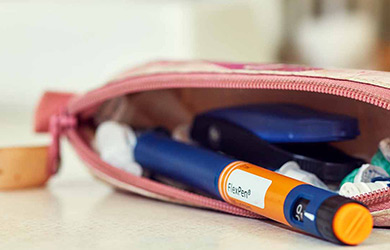
Insulin pen cleaning and care
Insulin pens need to be used and stored properly to function effectively. Learn how to care for your insulin pen.
Insulin is an essential hormone and chemical messenger produced by the pancreas. The function of insulin is to allow glucose found in the bloodstream to enter the body’s cells to provide energy. Insulin not only regulates blood sugar levels, but it also works to store excess glucose for energy, keeping blood sugar levels within a narrow range.
If you have diabetes, your body can’t naturally regulate your blood sugar levels through insulin production. In this instance, insulin treatment is used to mimic the natural insulin response of someone without diabetes.
It is important to get your blood sugar level under control when living with diabetes. When blood sugar levels are chronically high it can damage nerves, organs, and blood vessels.8
Insulin treatment can help people with type 1 and type 2 diabetes keep a balance of the right amount of insulin to maintain balanced blood sugar levels, which is important to stay healthy and avoid further illness later in life.
Insulin is produced by cells in the pancreas called the islets of Langerhans (or pancreatic islets). The pancreas contains around 1 million islets, and each islet houses four distinct cell types: alpha, beta and delta cells. The beta cells continuously release a small amount of insulin into the body and release surges of the hormone in response to a rise in the blood glucose level.
Type 1 diabetes is caused when immune cells make their way into the pancreas and destroy insulin-producing cells. In type 2 diabetes, insulin producing cells are also affected and the amount of insulin made can be impaired.
Having type 2 diabetes increases the risk of developing cardiovascular disease later in life. There are, however, many things you can do to reduce your risk including maintaining a healthy lifestyle with a balanced diet, exercise and by managing your diabetes.
People with type 1 diabetes make little or no insulin, and insulin treatment is vital to stay alive. Insulin can be self-administered through injections or insulin pumps (a small, computerised device). There’s also a variety of insulin treatment types for type 1 diabetes, including:
Provides a constant, steady release of insulin
Brings down spikes in blood sugar after eating
Combines two insulins in a single injection
People with type 2 diabetes either produce insulin but fail to use it efficiently (insulin resistance) or don’t produce enough insulin to regulate glucose levels (insulin deficiency). Insulin isn’t the first port of call when treating type 2 diabetes, but as the disease progresses, insulin treatment is often used.
The types of insulin used for type 2 diabetes are the same as those used for type 1 (basal, mealtime and premixed), but it’s good to note that insulin types differ in three ways:
How quickly insulin works
When insulin has the greatest effect
How long insulin works for
